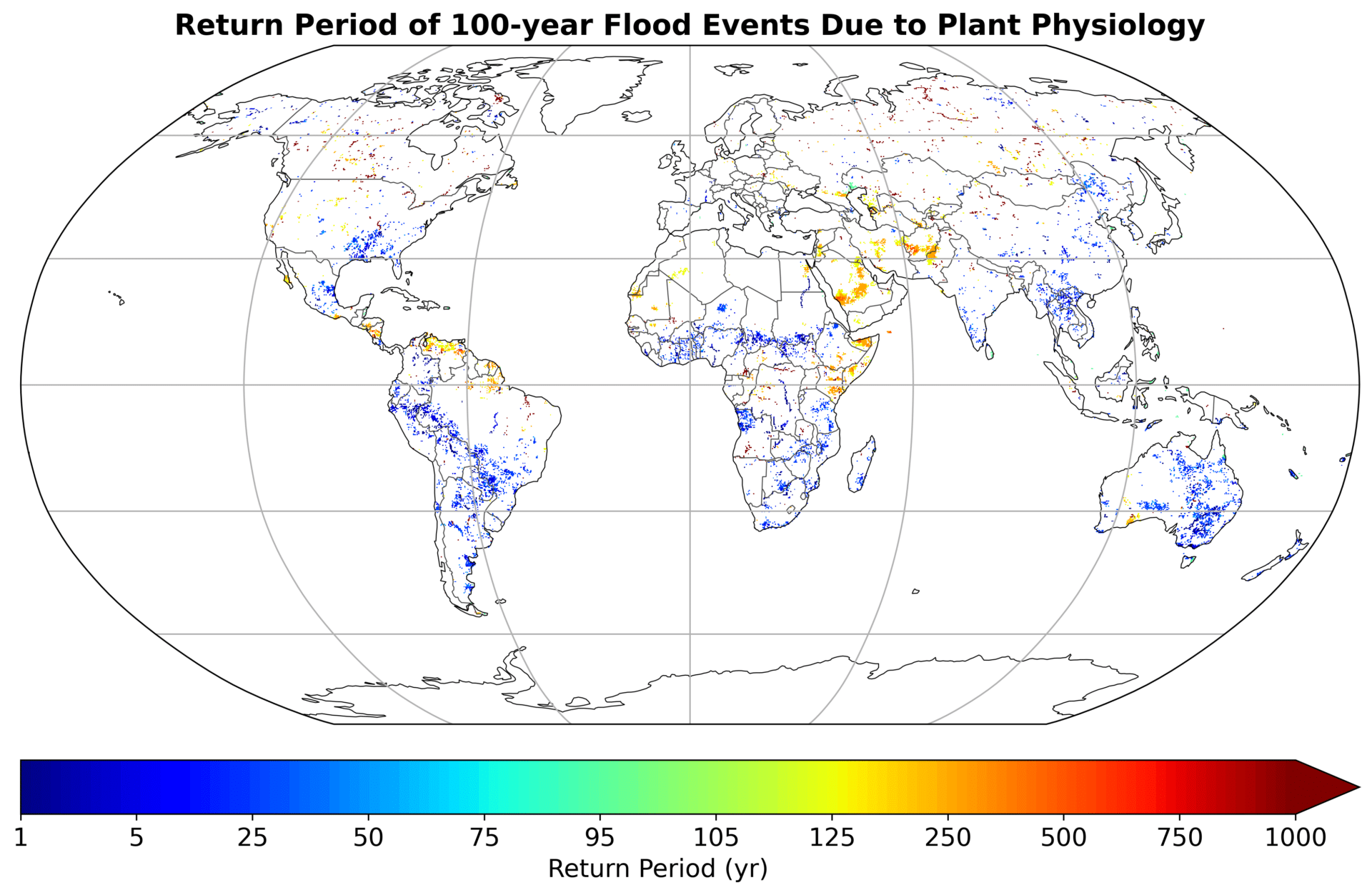How plants react to climate change could make floods a whole lot worse
By Chad Small | April 10, 2023
 Photo by Phillip Flores on Unsplash
Photo by Phillip Flores on Unsplash
Tree-planting is a cornerstone of numerous environmental and climate campaigns, and for seemingly good and logical reasons: When plants photosynthesize, they exchange carbon dioxide for oxygen.
The reality of planting trees to combat climate change is a bit more complicated. Planting the wrong trees in the wrong places can do more environmental harm than good. There is an ongoing debate as to whether reforestation will compete too much with necessary agriculture, or if trees—which can take a century to fully mature—will reach their peak carbon intake potential fast enough. And, as Sassan Saatchi, a senior scientist at NASA’s Jet Propulsion Laboratory in Pasadena, California, has said, tree planting will never be a substitute for decreasing fossil fuel emissions.
But there are other limits to using revegetation to combat the effects of climate change that haven’t been widely considered.
A team of atmospheric scientists have found that plants responding to elevated carbon dioxide in the atmosphere could increase regional flood risk—in some cases dramatically. Previously, the prevailing thought was that plants’ evapotranspiration rate—the process of exchanging carbon dioxide and water for oxygen—would increase in lockstep with atmospheric carbon dioxide levels. In reality, agricultural plants like wheat, rice, and cotton and most trees are more likely to see water vapor releases plateau as emissions climb. This could lead to potentially hyper-saturated soils, increasing flood risks and complicating water management and disaster planning.
Plant science. How much water plants release is directly tied to how much carbon dioxide they absorb through a process called stomatal conductance. Abigail Swann, a professor at the University of Washington and one of the researchers on the project mentioned above, explains that plants change how much their stomata open or close depending on the amount of carbon dioxide in the air. With more carbon dioxide in the atmosphere, plants don’t have to open their stomata quite so wide to get enough carbon dioxide to meet their photosynthetic needs.
This feature helps plants survive drought conditions. As Swann notes, for plants “it’s a cost to lose water to get carbon.” But in areas not suffering from water scarcity, however, elevated carbon dioxide levels could lead to plants giving off less water than they otherwise might, potentially causing nearby soils to become dangerously saturated. With nowhere else to go, incoming rainwater could cause nearby flooding.
Meg Fowler, a scientist at the National Center for Atmospheric Research, says she and her fellow researchers discovered just how potent this effect could be when her colleague, Gabe Kooperman, experimented with carbon dioxide inputs inside global climate models. As Kooperman, a professor at the University of Georgia, recalls, the goal of his original research was to see how plants’ release of water vapor affects local or regional precipitation. They found that if they quadrupled pre-industrial carbon dioxide levels in the atmosphere, plant-driven rainfall in regions like Southeast Asia increased tremendously.
Quadrupling pre-industrial carbon dioxide concentrations is a common way that climate scientists represent a very high emissions scenario for the end of this century. This method produces about a one percent increase in atmospheric carbon dioxide each year. The result is atmospheric carbon dioxide concentrations we might see in 2100 under the worst-case emissions scenario.
Fowler ran a similar analysis on flooding and runoff. The results were unexpected.
“Plants matter more than I think anyone thought they would,” she said.

Warm, rainy regions would be hardest hit. Under quadrupled carbon dioxide concentrations, plants could increase soil moisture so much that they change regional 100-year flood frequency. This could have dire impacts for many highly populated, already flood-prone regions.
Much of this regional difference comes from how different plants photosynthesize. Plants can be split into two categories, based on the specifics of their photosynthetic machinery: C3 and C4. These two plant types use different enzyme processes when they photosynthesize. This causes them to respond to carbon dioxide concentrations differently. C3 plants respond more strongly to high carbon dioxide concentrations, more readily closing their stomata when they’ve had enough carbon dioxide. Additionally, the way that C3 plants photosynthesize makes them much less hardy in hot, dry conditions. This means that C3 plants—the culprits for elevated flood risk—are more prevalent in rainy, warm climates.
Plant effects alone would change the 100-year flood return period in the Southeast United States to 25 years. A 100-year flood event has a one percent annual chance of happening. A 25-year return period quadruples that probability. Heavily populated regions in Southeastern Australia might see their return period dropped to 5 years, or a 20 times higher probability.

Blind spots in our models. Research into stomatal conductance as a potential runoff risk is relatively recent—which means that how global climate models assess flood risk may be flawed. Additionally, modelling vegetation responses to climatic changes can be uncertain since plant development depends on multiple—sometimes competing—factors, like nutrient and water availability. As Swann explains, global climate models often assume that the role of plants—in this case their stomatal conductance and consequent evapotranspiration—“would stay stationary.” Here, “stationary” means that plants’ evapotranspiration rate grows as carbon dioxide concentrations grow. But with C3 plants, that’s not always the case. As Kooperman notes, if you’re working “in a hydrodynamical model that doesn’t represent the vegetation effects, then you’re going to miss that part of the process.”
The world is not yet at quadrupled carbon dioxide concentrations, but other research has indicated that stomatal conductance effects have already elevated river runoff over the 20th century as emissions picked up. Kooperman says recognizing this reality should motivate “people that are doing future flood projection studies to make sure they’re accounting for this effect.”
“I think [this] is maybe a link in the step towards like what kind of infrastructure do we need to handle those floods,” he said.
Putting modeling into practice. In the United States, federal agencies often act in concert to respond to and prepare for severe flood events. The primary flood forecasting tool in the United States is the National Water Model.
“The idea of the National Water Model is that I can give you actionable—not just streamflow—information for every river, stream, creek across the nation,” said Paula Cognitore, Service Coordination Hydrologist at the National Water Center.
The National Water Model ingests information from over 3,400 locations in the continental United States. Parameters like precipitation intensity, reservoir levels, river and stream levels, and notably, soil moisture allow the National Water Model to simulate flood conditions. The hydrological model powering the National Water Model does consider both soil moisture and plant evapotranspiration—it just doesn’t consider the latter as it responds to long-term changes in carbon emissions.
According to Swann, hydrological models make “assumptions about hydrology” based on the plant side of the evapotranspiration equation, but in a stationary way. Incomplete assessments of changing biological influences on local hydrology could affect federal responses downstream.
While National Oceanographic and Atmospheric Administration (NOAA) does the heavy lifting in helping predict flood location and severity, the Federal Emergency Management Agency (FEMA) provides the emergency response once a flood arrives. Their response relies on the flood modelling and prediction provided by other agencies, like NOAA. According to Paul Rooney, Mapping Technology Specialist in FEMA’s Risk Management Directorate, his agency often looks to its partner agencies when gathering climatological and meteorological information that feeds its flood risk models.
“We’re not necessarily looking to be the climate scientists who are going to estimate what those impacts are going to be,” he explained. “We’re going to go to NOAA and [United States Geological Survey] or some kind of government consensus on what those things might be.”
In terms of plants’ intensifying flood severity in America, it’s likely that federal agencies will likely miss it. In the immediate term, Kooperman thinks that may not be a huge issue.
Because “the CO2 response we have right now is much lower than what we’re using in these simulations” researchers can’t yet quantify present risk from stomatal conductance, Kooperman notes. But as prior research has shown, the effect on river runoff has been notable in the past. And as emissions rise, so will plants’ role in the flood equation.
Researchers still don’t have the full picture of plant impacts on flood severity, but the continued rise of carbon emissions will present more unpredictable risks than if emissions were contained or limited. Even accounting for these uncertainties, plant cover is better than bare ground or impervious surfaces like pavement, which have a far greater impact on flood risks.
Capturing the true extent to which plants affect future flood risk scenarios requires that researchers and models treat the Earth system as a system in which inputs are dynamic and talk to each other. The biggest takeaway from the research into rising carbon dioxide levels and flood risks, Fowler said, is “convey[ing] the importance of an interactive Earth system as opposed to each of us studying in a silo and working on one individual thing.”
Together, we make the world safer.
The Bulletin elevates expert voices above the noise. But as an independent nonprofit organization, our operations depend on the support of readers like you. Help us continue to deliver quality journalism that holds leaders accountable. Your support of our work at any level is important. In return, we promise our coverage will be understandable, influential, vigilant, solution-oriented, and fair-minded. Together we can make a difference.
Keywords: climate crisis, climate modelling, climate models, flood risk assessment, flooding, floods
Topics: Climate Change















